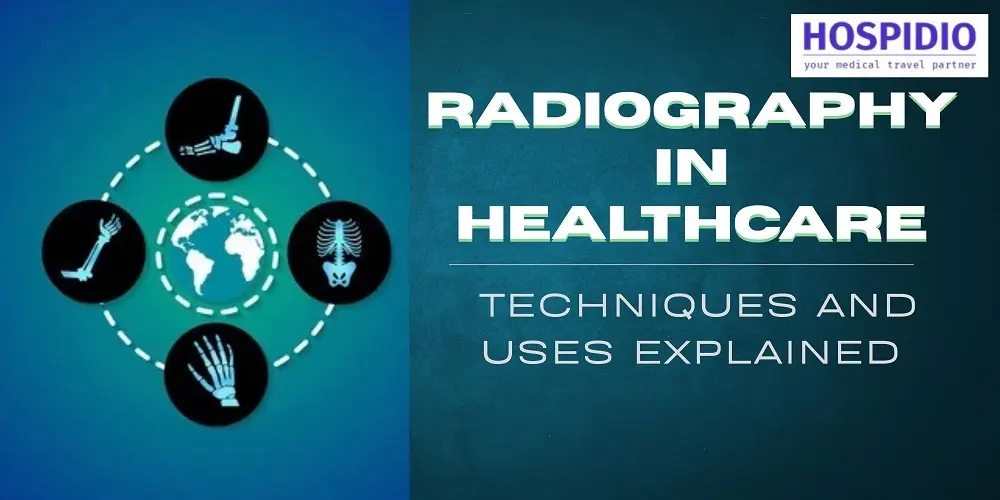In modern healthcare, radiography has become an indispensable tool, enabling medical professionals to visualize internal body structures without invasive procedures. From diagnosing fractures to detecting tumors, radiography plays a crucial role in providing accurate insights that aid in effective patient care and treatment planning.
In this blog we will get to know about what radiography is, how it works and what its application is.
What is Radiography ?
Radiography is the study of internal body structures with the help of X-ray images. X-rays are electromagnetic waves that are able to penetrate objects, such as the body, thereby producing different effects depending on the thickness of the tissues. For instance, X-rays have a high absorption rate in thick structures, such as bone, which turns them white in the X-ray image, unlike more flexible structures that appear in different shades of grey or even black.
X-ray images are known as radiographs, which allows physicians to visualise the interior of a body to give an important diagnosis.
Types of Radiography
There are several forms of radiography, each radiograph have a different purpose in healthcare:
- Conventional X-rays: This is a common type of radiography that is used for diagnosing fractures, infections, or locating foreign objects.
- Fluoroscopy: A type of radiography that provides real time moving images, used during diagnostic procedures like barium X-rays or to guide the placement of a catheter.
- CT Scans (Computed Tomography): In this type of radiography X-rays are taken from different angles to create detailed cross sectional images of the body.
- Mammography: It captures detailed images of breast tissue and is commonly used for the early detection of breast cancer.
- Interventional Radiology: It is a medical specialty that uses imaging techniques, such as X-rays, MRI, and ultrasound, to guide minimally invasive procedures for diagnosing and treating various conditions within the body.
Get a free cost estimate
How Does Radiography Work ?
The X-ray tube's capacity to function is what essentially drives the radiography process. When a machine generates X-rays for a human body examination, the radiation enters the body and is differently affected by various internal structures. A device that creates an image from the remaining X-rays is placed on the other side of the body.
The X-ray machine emits radiation that travels through the body, producing an image by capturing the varying absorption levels of different tissues.
Examples of this include specific cell clusters, like bones, which absorb more X-rays and seem white in the image, but the tissues of muscles and other organs absorb fewer X-rays and appear grey or black. A radiology specialist can search for any problems, including infections, cancers, cysts, and fractures, thanks to the densities seen in the images.
The Role of a Radiologic Technologist
Radiography is not possible without the skilled technologists who operate the machines, position patients for the best possible images, and ensure radiation safety. These are the steps for accurate diagnostic images, and they work closely with radiologists.
Radiation Safety
Since radiography involves exposure to X-rays, radiation safety is a critical concern. While the radiation used in medical imaging is typically low, technologists ensure patients and themselves are exposed to the least amount of radiation possible. Protective measures, such as lead aprons or shields, are often used to protect areas of the body not being imaged.
Why Radiography Matters
Radiography helps healthcare by allowing doctors to “see” inside the body without the need for invasive surgery. It's widely used in both emergency situations, like evaluating trauma or fractures, and in routine checkups, such as dental X-rays or lung screenings.
Radiography is important for early detection and diagnosis of many conditions. For example, a simple chest X-ray can reveal pneumonia or lung cancer in its early stages. Early diagnosis often leads to better treatment outcomes, which makes radiography a vital tool in preventive medicine and invasive surgery.
The Future of Radiography
The advanced level of radiography increases with technological innovation. Digital radiography has largely replaced classical film-based x-ray imaging because it provides faster and better results, an effective archiving system, and the ability to enhance images for precise diagnosis. Artificial intelligence may be used in radiograph assessment in the future, speeding up and improving accuracy of the procedure and assisting medical professionals to detect diseases they might have missed otherwise.
Radiography and medical imaging clothes may benefit from evolving technology as it continues to become more accurate and productive.
Conclusion
Radiography has become a crucial part of modern medicine, offering a non invasive, efficient, and highly effective way to examine the internal structures of the body. From diagnosing fractures to detecting cancers, it plays a critical role in both emergency situations and routine health screenings. Skilled radiologic technologists and advancements in technology, such as digital radiography and potentially AI, have significantly improved the accuracy and speed of diagnosis, ensuring better outcomes for patients.
As technology continues to evolve, radiography is expected to become even more precise, paving the way for faster diagnoses and enhanced patient care. With its ability to provide early detection of diseases, radiography remains a cornerstone of preventive medicine and healthcare diagnostics.
Himang
Author
Himang Gupta is a skilled medical content writer with a Bachelor's degree in Biotechnology and extensive experience crafting engaging and informative blogs. Passionate about simplifying complex medical topics, he ensures his content resonates with readers. When not researching or writing, Himang enjoys scrolling Instagram, cracking jokes, and savoring the flavor of elaichi—his ultimate treat after a productive writing session.
Guneet Bindra
Reviewer
Guneet Bhatia is the Founder of HOSPIDIO and an accomplished content reviewer with extensive experience in medical content development, instructional design, and blogging. Passionate about creating impactful content, she excels in ensuring accuracy and clarity in every piece. Guneet enjoys engaging in meaningful conversations with people from diverse ethnic and cultural backgrounds, enriching her perspective. When she's not working, she cherishes quality time with her family, enjoys good music, and loves brainstorming innovative ideas with her team.

